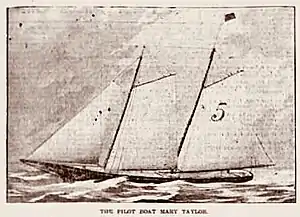Mary Taylor (pilot boat)
The Mary Taylor was a 19th-century yacht and Sandy Hook pilot boat, built in 1849 for New York Pilots. She was designed by George Steers with a new radical design with a long thin bow and wide stern, which made her faster than any other boat in her class. This design proved successful and led to the famous yacht America, which won the America's Cup in 1851.
 New York pilot boat Mary Taylor | |
| History | |
|---|---|
| Name: | Mary Taylor |
| Namesake: | Mary Taylor, popular New York actress |
| Owner: | New York Pilots |
| Operator: | Captain Richard Brown |
| Builder: | Hathorne & Steers shipyard |
| Launched: | 1849 |
| Out of service: | November 10, 1863 |
| Fate: | Sank at sea on November 10, 1863 |
| General characteristics | |
| Class and type: | schooner |
| Tonnage: | 75-tons TM[1]:p72 |
| Length: | 67 ft 0 in (20.42 m) |
| Beam: | 17 ft 10 in (5.44 m) |
| Depth: | 7 ft 9 in (2.36 m) |
| Propulsion: | Sail |
Construction and service
New York pilot boat Mary Taylor, was built in early 1849 at the Hathorne & Steers shipyard, at the foot of North First street, in Williamsburg, New York.[2] She was designed by George Steers for Captain Richard "Dick" Brown. Steers designed her with a new thin bow and wide stern, which made her faster than any boat of her size. Fitting with the new design, Brown named her after a scandalous New York actress Mary Taylor, known for dancing the bawdy polka. The schooner was a big success, out sailing other boats in the pilot fleet.[1][3] The Mary Taylor was followed the next year by the Moses H. Grinnell, which led to the famous yacht America, which won the America's Cup.[4][5]
The following is from Steers about the Mary Taylor:
When George Steers laid the keel of the pilot boat, Mary Taylor, he engaged in advance to make a faster and steadier craft that had ever left the port of New York, and he succeeded exactly according to expectation. For encountering less resistance from the narrow bows, the vessel went faster, experienced no corresponding strain, and suffered no more in the storm than in the breeze.[2][6]
The sail number "5" was painted as a large number on the mainsail identified the boat as belonging to the Sandy Hook Pilots. Based on this number, the Mary Taylor No. 5, appeared in several prominent newspapers from 1849–1863.[5] She was gaff rigged, two-masted schooner, 67 feet long; 17.10 feet beam; and 7.9 feet in depth.[1]:p72 Without the success of the Mary Taylor, the America may not have been built.[7]
End of service
On November 10, 1863, the Mary Taylor, No. 5, was lost by an American three-masted schooner Fairhaven, near Barnegat, New Jersey. A crew of six on board were saved.[8][9]:p23[1]
Mary E. Fish
The New Jersey pilot-boat Mary E. Fish, No. 4, was built to replace the Mary Taylor.[9]:p23 She was built from the Edward F. Williams shipyaard of Greenpoint, Brooklyn.[10]
On 24 Apr 1861, the Mary E. Fish was launched for New Jersey and Sandy Hook pilots from the Edward F. Williams shipyard.[11]
On 9 October 1873, the Mary E. Fish was one of the boats that participated in the Ocean Regatta, which was a race from Owl's Head Point around to Cape May Lighthouse in New Jersey, and back to the Sandy hook Lightship.[12] Richard Brown was the captain and part owner of the pilot boat Mary E. Fish. He helped supervise the construction of the Fish and served aboard as master her from 1876 to 1885.[13][5]
References
- Cunliffe, Tom (2001). Pilots, The World Of Pilotage Under Sail and Oar. Brooklin, Maine: Wooden Boat Publications. p. 72. ISBN 9780937822692.
- Neblett, Thomas R. (2009). Civil War Yacht. Mustang, Oklahoma: Tate Publishing & Enterprises. pp. 36–45.
- "Museum Exhibition Commemorates Yacht Races For America's Cup". New York Daily Tribune. New York, New York. 28 May 1850. Retrieved 2020-12-03 – via Newspapers.com.
- Russell, Charles Edward (1929). From Sandy Hook to 62°. New York: Century Co. pp. 94–95. OCLC 3804485.
- Shaw, David W. (2004). America's Victory: The Heroic Story of a Team of Ordinary Americans. ISBN 9781574091878. Retrieved 2 August 2020.
- William Ross Wallace, 1860, The Loved and the Lost, "An American Shipbuilder." New York.
- "Was An Experimental America. The Mary Taylor, Pilot Boat Designed by George Steers, Proceeded the Famous Cup Winner by a Year, and Contained All the Elements of Design That Made the America Fast-Her Great Influence on American Yachting". The Boston Globe. Boston, Massachusetts. 17 Jul 1904. p. 53. Retrieved 2020-12-03 – via Newspapers.com.
- "Yesterday's Dispatches". Buffalo Courier. Buffalo, New York. 11 Nov 1863. p. 1. Retrieved 2020-12-03 – via Newspapers.com.
- Allen, Edward L. (1922). Pilot Lore From sail to Steam. New York: The United New York and New Jersey Sandy Hook Pilots Benevolent Associations. p. 22.
- "the Pilot Yachts". Brooklyn Evening Star. Brooklyn, New York. 13 September 1862. Retrieved 17 August 2020.
- "Launch". New York Daily Herald. New York, New York. 24 Apr 1861. p. 11. Retrieved 2021-01-03 – via Newspapers.com.
- Loubat, Joseph Florimond (1887). A yachtsman's scrap book: or, The ups and downs of yacht racing. New York: Brentano Brothers. pp. 42–106.
- "Record of American and Foreign Shipping 1876". Mystic Seaport Museum. New York. Retrieved 2020-12-03.
